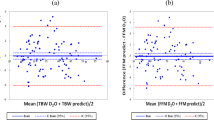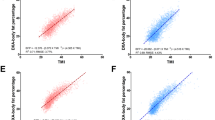Abstract
Background/Objective:
The aim of this study was to assess the validity of body fatness estimations based on skinfolds and bioelectrical iImpedance analyses (BIA) measurements compared to a three-component model (3C model) in prepubertal Chilean children, considering potential differences by sex and nutritional status.
Subjects/Methods:
Four hundred and twenty four Chilean children (198 females and 226 males) were assessed for body composition. Body fat percentage (BF%) was evaluated by Skinfold equations (Slaughter, Ramirez and Huang) and Bioelectrical impedance (BIA: Tanita BC-418MA) using both the equipment and the Ramirez equation. Measurements based on a 3C model constructed from total body water estimates by isotope dilution and from body volume estimates by air displacement plethysmography were used as gold standard.
Results:
Coefficient of determination (R2) values were higher in overweight and in the whole group of both gender. All slopes were differed significantly from 1, and most intercepts were significantly different from 0. Skinfold Equations: an underestimation of BF% was found for all equations, being higher with the Slaughter equation. BIA: Tanita underestimated BF% in all groups, whereas Ramirez equation shows an overestimation.
Conclusions:
Skinfolds and bio-impedance equations serve well to rank children according to their BF%. However, these methods are not accurate for describing body composition in prepubertal Chilean children.
This is a preview of subscription content, access via your institution
Access options
Subscribe to this journal
Receive 12 print issues and online access
$259.00 per year
only $21.58 per issue
Buy this article
- Purchase on Springer Link
- Instant access to full article PDF
Prices may be subject to local taxes which are calculated during checkout
Similar content being viewed by others
References
Prentice AM, Jebb SA . Beyond body mass index. Obes Rev 2001; 2: 141–147.
Melanson KJ, McInnis KJ, Rippe JM, Blackburn G, Wilson PF . Obesity and cardiovascular disease risk: research update. Cardiol Rev 2001; 9: 202–207.
Fortuño A, Rodríguez A, Gómez-Ambrosi J, Frühbeck G, Díez J . Adipose tissue as an endocrine organ: role of leptin and adiponectin in the pathogenesis of cardiovascular diseases. J Physiol Biochem 2003; 59: 51–60.
Wells JCK, Fewtrell MS . Measuring body composition. Arch Dis Child 2006; 91: 612–617.
Slaughter MH, Lohman TG, Boileau RA, Horswill CA, Stillman RJ, Van Loan MD et al. Skinfold equations for estimation of body fatness in children and youth. Hum Biol 1988; 60: 709–723.
Ramírez E, Valencia ME, Bourges H, Espinosa T, Moya-Camarena SY, Salazar G et al. Body composition prediction equations based on deuterium oxide dilution method in Mexican children: a national study. Eur J Clin Nutr 2012; 66: 1099–1103.
Huang TT-K, Watkins MP, Goran MI . Predicting total body fat from anthropometry in Latino children. Obes Res 2003; 11: 1192–1199.
Pietrobelli A, Rubiano F, St-Onge M-P, Heymsfield SB . New bioimpedance analysis system: improved phenotyping with whole-body analysis. Eur J Clin Nutr 2004; 58: 1479–1484.
Sluyter JD, Schaaf D, Scragg RKR, Plank LD . Prediction of fatness by standing 8-electrode bioimpedance: a multiethnic adolescent population. Obesity 2010; 18: 183–189.
Prins M, Hawkesworth S, Wright A, Fulford AJC, Jarjou LMA, Prentice AM et al. Use of bioelectrical impedance analysis to assess body composition in rural Gambian children. Eur J Clin Nutr 2008; 62: 1065–1074.
WHO Multicentre Growth Reference Study Group. WHO Child Growth Standards based on length/height, weight and age. Acta Paediatr Suppl 2006; 450: 76–85.
WHO Multicentre Growth Reference Study Group. Reliability of anthropometric measurements in the WHO Multicentre Growth Reference Study. Acta Paediatr Suppl 2006; 450: 38–46.
Fields DA, Hull HR, Cheline AJ, Yao M, Higgins PB . Child-specific thoracic gas volume prediction equations for air-displacement plethysmography. Obes Res 2004; 12: 1797–1804.
Fuller NJ, Jebb SA, Laskey MA, Coward WA, Elia M . Four-component model for the assessment of body composition in humans: comparison with alternative methods, and evaluation of the density and hydration of fat-free mass. Clin Sci 1992; 82: 687–693.
Siri WE . Body composition from fluid spaces and density: analysis of methods. 1961. Nutrition 1993; 9: 480–491.
Bland JM, Altman DG . Statistical methods for assessing agreement between two methods of clinical measurement. Lancet 1986; 1: 307–310.
StataCorp LP . Stata Statistical Software: Release 10. StataCorp LP: College Station, TX: College Station, TX, 2007.
Cameron N, Griffiths PL, Wright MM, Blencowe C, Davis NC, Pettifor JM et al. Regression equations to estimate percentage body fat in African prepubertal children aged 9 y. Am J Clin Nutr 2004; 80: 70–75.
Kyle UG, Bosaeus I, De Lorenzo AD, Deurenberg P, Elia M, Gómez JM et al. Bioelectrical impedance analysis—part I: review of principles and methods. Clin Nutr 2004; 23: 1226–1243.
Osborne DL, Weaver CM, McCabe LD, McCabe GP, Novotny R, Van Loan MD et al. Body size and pubertal development explain ethnic differences in structural geometry at the femur in Asian, Hispanic, and white early adolescent girls living in the U.S. Bone 2012; 51: 888–895.
Rush EC, Puniani K, Valencia ME, Davies PSW, Plank LD . Estimation of body fatness from body mass index and bioelectrical impedance: comparison of New Zealand European, Maori and Pacific Island children. Eur J Clin Nutr 2003; 57: 1394–1401.
Haroun D, Taylor SJC, Viner RM, Hayward RS, Darch TS, Eaton S et al. Validation of bioelectrical impedance analysis in adolescents across different ethnic groups. Obesity 2010; 18: 1252–1259.
Bray GA, DeLany JP, Volaufova J, Harsha DW, Champagne C . Prediction of body fat in 12-y-old African American and white children: evaluation of methods. Am J Clin Nutr 2002; 76: 980–990.
Mitsui T, Shimaoka K, Tsuzuku S, Kajioka T, Sakakibara H . Accuracy of body fat assessment by bioelectrical impedance in Japanese middle-aged and older people. J Nutr Sci Vitaminol 2006; 52: 154–156.
Wells JCK . Sexual dimorphism of body composition. Best Pract Res Clin Endocrinol Metab 2007; 21: 415–430.
Federico B, D’Aliesio F, Pane F, Capelli G, Rodio A . Body mass index has a curvilinear relationship with the percentage of body fat among children. BMC Res Notes 2011; 4: 301.
Acknowledgements
This work was supported by the Fondo Nacional de Ciencia y Tecnología de Chile (Fondecyt), Grant # 1090252, 1100206.
Author information
Authors and Affiliations
Corresponding author
Ethics declarations
Competing interests
The authors declare no conflict of interest.
Additional information
Supplementary Information accompanies this paper on European Journal of Clinical Nutrition website
Rights and permissions
About this article
Cite this article
Aguirre, C., Salazar, G., Lopez de Romaña, D. et al. Evaluation of simple body composition methods: assessment of validity in prepubertal Chilean children. Eur J Clin Nutr 69, 269–273 (2015). https://doi.org/10.1038/ejcn.2014.144
Received:
Revised:
Accepted:
Published:
Issue Date:
DOI: https://doi.org/10.1038/ejcn.2014.144



